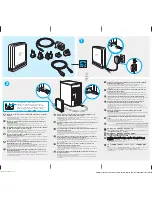
Organizing Your E-Mail
53
Novell Confidential
Manual (ENU) 21 December 2004
Creating New Filter Rules
1
Click Edit > Message Filters.
2
Click Add.
3
Type a name for the filter in the Rule name field.
4
Define the criteria for the filter in the If section.
For each of the filter criteria, you must first select which parts of the message you want to
filter:
Sender:
The sender’s address.
Recipient:
The recipients of the message.
Subject:
The subject line of the message.
Specific Header:
Any header including custom ones.
If a message uses a header more than once, Evolution pays attention only to the first instance,
even if the message defines the header differently the second time. For example, if a message
declares the Resent-From: header as “[email protected]” and then restates it as
“[email protected],” Evolution filters as though the second declaration did not occur.
To filter on messages that use headers multiple times, use a regular expression.
Message Body:
Searches in the actual text of the message.
Expression:
(For programmers only) Match a message according to an expression you write
in the Scheme language, used to define filters in Evolution.
Date Sent:
Filters messages according to the date on which they were sent. First, choose the
conditions you want a message to meet, such as before a given time or after a given time. Then
choose the time. The filter compares the message’s time stamp to the system clock when the
filter is run, or to a specific time and date you choose from a calendar. You can also have it
look for a message within a range of time relative to the filter, such as two to four days ago.
Date Received:
This works the same way as the Date Sent option, except that it compares the
time you received the message with the dates you specify.
Label:
Messages can have labels of Important, Work, Personal, To Do, or Later. You can set
tables with other filters or by hand.
Score:
Sets the message score to any whole number greater than 0. You can have one filter set
or change a message score, and then set up another filter to move the messages you have
scored. A message score is not based on anything in particular: it is simply a number you can
assign to messages so other filters can process them.
Size:
Sorts based on the size of the message in kilobytes.
Status:
Filters according to the status of a message. The status can be Replied To, Draft,
Important, Read, or Junk.
Flagged:
Checks whether the message is flagged for follow-up.
Attachments:
Creates a filter based on whether there is an attachment for the e-mail.
Mailing List:
Filters based on the mailing list the message came from. This filter might miss
messages from some list servers, because it checks for the X-BeenThere header, which is used
to identify mailing lists or other redistributors of mail. Mail from list servers that do not set
X-BeenThere properly are not be caught by these filters.
Summary of Contents for EVOLUTION 2.6
Page 4: ...4 Evolution User Guide Novell Confidential Manual ENU 21 December 2004 ...
Page 32: ...32 Evolution User Guide Novell Confidential Manual ENU 21 December 2004 ...
Page 58: ...58 Evolution User Guide Novell Confidential Manual ENU 21 December 2004 ...
Page 86: ...86 Evolution User Guide Novell Confidential Manual ENU 21 December 2004 ...
Page 100: ...100 Evolution User Guide Novell Confidential Manual ENU 21 December 2004 ...
Page 110: ...110 Evolution User Guide Novell Confidential Manual ENU 21 December 2004 ...
Page 118: ...118 Evolution User Guide Novell Confidential Manual ENU 21 December 2004 ...
Page 120: ...120 Evolution User Guide Novell Confidential Manual ENU 21 December 2004 ...
Page 122: ...122 Evolution User Guide Novell Confidential Manual ENU 21 December 2004 ...
















































